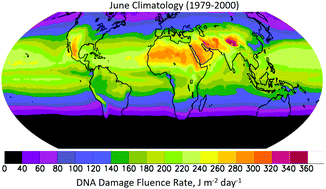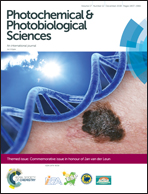Solar UV radiation and microbial life in the atmosphere†
Abstract
Many microorganisms are alive while suspended in the atmosphere, and some seem to be metabolically active during their time there. One of the most important factors threatening their life and activity is solar ultraviolet (UV) radiation. Quantitative understanding of the spatial and temporal survival patterns in the atmosphere, and of the ultimate deposition of microbes to the surface, is limited by a number factors some of which are discussed here. These include consideration of appropriate spectral sensitivity functions for biological damage (e.g. inactivation), and the estimation of UV radiation impingent on a microorganism suspended in the atmosphere. We show that for several bacteria (E. coli, S. typhimurium, and P. acnes) the inactivation rates correlate well with irradiances weighted by the DNA damage spectrum in the UV-B spectral range, but when these organisms show significant UV-A (or visible) sensitivities, the correlations become clearly non-linear. The existence of these correlations enables the use of a single spectrum (here DNA damage) as a proxy for sensitivity spectra of other biological effects, but with some caution when the correlations are strongly non-linear. The radiative quantity relevant to the UV exposure of a suspended particle is the fluence rate at an altitude above ground, while down-welling irradiance at ground-level is the quantity most commonly measured or estimated in satellite-derived climatologies. Using a radiative transfer model that computes both quantities, we developed a simple parameterization to exploit the much larger irradiance data bases to estimate fluence rates, and present the first fluence-rate based climatology of DNA-damaging UV radiation in the atmosphere. The estimation of fluence rates in the presence of clouds remains a particularly challenging problem. Here we note that both reductions and enhancements in the UV radiation field are possible, depending mainly on cloud optical geometry and prevailing solar zenith angles. These complex effects need to be included in model simulations of the atmospheric life cycle of the organisms.

- This article is part of the themed collection: Commemorative issue in honour of Jan van der Leun


 Please wait while we load your content...
Please wait while we load your content...
